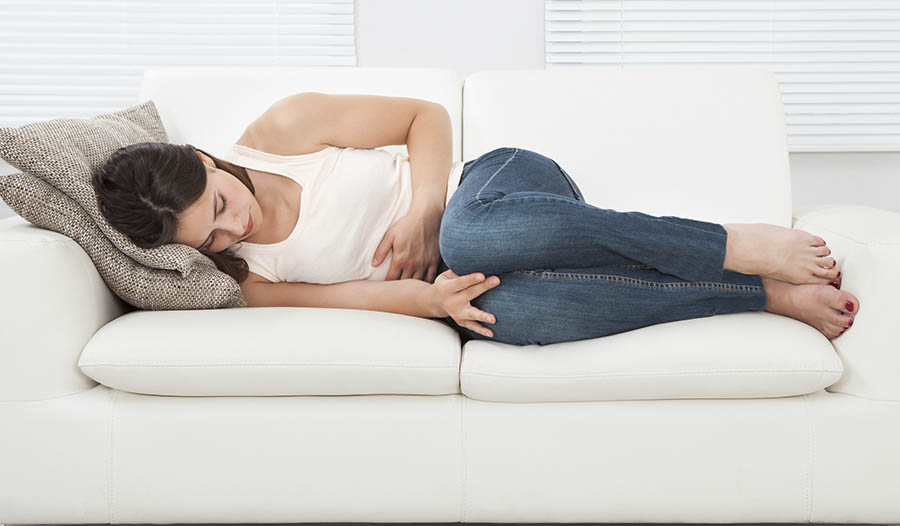Seven Secrets for PMS Symptom Relief

Premenstrual syndrome (PMS) is a recurrent condition in women characterized by troublesome symptoms seven to fourteen days before menstruation. Typical symptoms include decreased energy level, tension, irritability, depression, headache, altered sex drive, breast pain, backache, abdominal bloating, and edema of the fingers and ankles. Severe PMS, with depression, irritability, and extreme mood swings, is referred to as premenstrual dysphoric disorder.
For many years, it was commonly believed that elevated estrogen levels and reduced progesterone levels five to ten days before the menses were responsible for PMS. However, this belief is no longer popular. The dominant thought now is that rather than alterations in estrogen and progesterone levels in the blood, PMS is the result of alterations in brain chemistry that influence many factors, including the sensitivity of the brain to hormones. The chief factor that is most often promoted as the underlying issue in PMS is lower levels of the neurotransmitter serotonin. Not surprisingly, recent research shows that many of the natural antidepressant agents may have benefits for PMS.
Natural relief with diet and dietary supplements
- Reduce or eliminate the amount of animal products in the diet and increase consumption of fiber-rich plant foods, including fruits, vegetables, grains, and legumes. Vegetarian women have been shown to excrete two to three times more estrogen in their feces and have 50 percent lower levels of free estrogen in their blood than omnivores. These differences are thought to be a result of the lower fat and higher fiber intake of vegetarians.
- Reduce or eliminate caffeine consumption. Considerable evidence suggests that caffeine consumption is strongly related to the presence and severity of PMS. Therefore, caffeine must also be avoided by women with PMS. The effect of caffeine is particularly significant in the psychological symptoms associated with PMS, such as anxiety, irritability, insomnia, and depression. Caffeine also has an adverse effect on the way estrogen stimulates breast tissue, which may contribute to breast tenderness and fibrocystic breast disease.
- Eat more soy. There is also evidence that phytoestrogens may exert a balancing effect when estrogen levels are high, as is commonly seen in PMS. The consumption of soy foods is the most economical, and possibly the most beneficial, way to increase the intake of phytoestrogens. Vitamin B6 also has an effect on the metabolism of estrogen. Vitamin B6 is found in yams, leafy green vegetables and legumes.
- Cut back on salt. Excessive salt (sodium chloride) consumption, coupled with diminished dietary potassium, greatly stresses the kidneys’ ability to maintain proper fluid volume. As a result, some people are “salt-sensitive,” in that high salt intake causes high blood pressure or, in other cases, water retention. In general, it is a good idea to avoid salt if you have PMS. If you tend to notice more water retention during the latter part of your menstrual cycle, reducing your salt intake is an absolute must.
- Supplement the diet with key nutrients. As stated above, vitamin B6 is critical to maintaining hormonal balance. Vitamin B6 supplementation has been shown to exert positive effects on all PMS symptoms (particularly depression) in many women. The improvement is achieved via a combined reduction in mid-luteal estrogen levels and an increase in mid-luteal progesterone levels. Since 1975, there have been at least a dozen double-blind clinical trials. In most situations, the therapeutic dosage of 50 to 100 mg per day is generally regarded as safe, even for long-term use.
Magnesium deficiency is strongly implicated as a causative factor in premenstrual syndrome. Red blood cell magnesium levels in PMS patients have been shown to be significantly lower than in subjects without PMS. As magnesium plays such an integral part in normal cell function, magnesium deficiency may account for the wide range of symptoms attributed to PMS. While magnesium supplementation has been shown to be effective on its own, even better results may be achieved by combining it with vitamin B6 and other nutrients. Several studies have shown that when PMS patients are given a multivitamin and mineral supplement containing high doses of magnesium and pyridoxine (vitamin B6), they experience a tremendous reduction in PMS symptoms. The recommended range for magnesium intake is 300 to 450 mg daily.
Calcium supplementation has produced significant improvements in PMS symptoms in double-blind studies. It is theorized, based primarily on animal research, that calcium improves the altered hormonal patterns, neurotransmitter levels, and smooth muscle responsiveness noted in PMS. Further support for the importance of calcium supplementation in soothing PMS symptoms was the finding that women with PMS have reduced bone mineral density. The recommended dosage for calcium in PMS is 1,000 to 1,500 mg daily.
Zinc levels have been shown to be lower in women who have PMS. Zinc is required for proper action of many body hormones, including sex hormones, as well as in the control of the secretion of hormones. The suggested range for zinc supplementation is 15 to 20 mg.
- Try taking a supplement that contains chasteberry. Chasteberry (Vitex agnus-castus) extract appears quite helpful in mitigating the symptoms of PMS. In two surveys of gynecological practices in Germany, physicians graded chasteberry extract as good or very good in the treatment of PMS. More than 1,500 women participated in studies of chasteberry. One-third of the women experienced complete resolution of their symptoms, while another 57% reported significant improvement and 90% reported improvement or resolution. Chasteberry extract appears to be particularly useful in cases of corpus luteum insufficiency or prolactin excess. The usual amount of chasteberry extract to take (often standardized to contain 0.5 percent agnuside) in tablet or capsule form is 175 to 225 mg per day. If you are using the liquid extract, the typical amount is 2 ml per day.
- Give Ginkgo bilobaextract (GBE) a try. While GBE is well known for its effects in improving blood flow to the brain, it has also been shown to be of great benefit in PMS in several clinical trials. It not only improves psychological complaints of PMS, it also improves some of the physical issues. For example, in a double-blind study of 165 women with PMS, those who took GBE at 80 mg twice daily from day 16 to day five of their cycles showed considerable benefit. Symptom diaries kept by patients and physician evaluation of symptoms demonstrated that GBE was particularly effective in relieving the breast pain and tenderness experienced by some women with PMS.
What about serotonin?
You may be asking, “If one of the primary features of PMS for most women is reduced serotonin levels, how do I raise it?” While it is becoming increasingly popular for doctors to prescribe selective serotonin reuptake inhibitor drugs like Prozac, Zoloft, Paxil and their generic forms to raise serotonin levels, there are a number of natural compounds that offer some advantages. While these drugs carry with them significant concerns over side-effects (including weight gain), several natural alternatives have been shown to offer comparable benefits with a better side-effects profile. My choice is to reserve the use of the natural antidepressants until after two months of the seven recommendations above unless depression is a major PMS issue, then I would recommend starting immediately. While St. John’s wort extract has the greatest support in clinical studies in PMS (and depression) at a dosage of 900 to 1,800 mg daily, I really think the effects of 5-HTP better fit the typical PMS patient profile (especially if sugar cravings are a big issue). 5-HTP is the intermediate step in the conversion of the amino acid tryptophan to serotonin. It exerts significant advantages over tryptophan as a strategy to boost serotonin levels. And while there are studies showing tryptophan supplementation to be helpful in PMS, my feeling is that if there were studies comparing the two, there would be no comparison at all as 5-HTP would greatly outperform tryptophan. My recommendation for PMS sufferers is to take 50 to 100 mg of 5-HTP 20 minutes before meals on day 17 of their cycle to day three of menses. If they suffer from low mood or sugar cravings throughout the month, then I recommend it throughout the month as well.
DISCLAIMER:This Wellness Hub does not intend to provide diagnosis...













































































 Table of Contents
Table of Contents
















